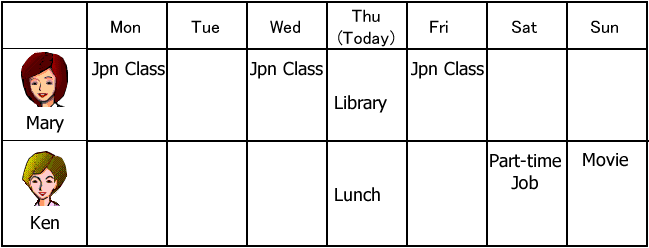DATE: See the Course Portal
Each pair will be given up to 3 minutes to role play on the given topic. (You are not allowed to read from a draft.) Note that the presentation must be conducted in Japanese. If your presentation includes substantial amount of English, your overall grade will be lowered. Also, if the presentation includes inappropriate expressions (e.g., offensive expressions) your grade will be deducted. The drafts must be double-spaced.
| Items to submit | (Look up in the Course Portal for the deadlines.). |
| First Draft (double-spaced; handwritten or typed) | Regular class --- Submit the hard copy in class. Online class --- Upload the file to T-Square's Drop Box. Create a folder "Presentation2" and upload it to the folder. |
| Power
Point (Visual Aid) Page 1: New vocabulary page if any. Page 2+: Visual aids which support your role play |
All classes --- Upload the PowerPoint file to T-Square's Drop box. (PowerPoint file should NOT contain the actual draft (text) of your speech. You can use a notecard with a skeletal outline if necessary, but you are not allowed to read from the draft.) |
| Presentation (Role Play) | Comprehension questions will be asked after each role play . |
| Final Draft (Double-spaced; handwritten or typed) | Regular class --- Submit the hard copy in class. Online class --- Upload the file to T-Square's Drop Box. Put it into the same folder "Presentation2" created before. |
"Describing your daily activities and the location of things"
Although you are allowed to include some (not a whole lot of) new grammar/vocabulary, there is no need or advantage in doing so. You will not receive any extra credits on your attempt to include new grammar and/or vocabulary never introduced in class. You will not be penalized for your attempts, but you will not gain any advantage. It's more important that you demonstrate your correct skills and knowledge of the grammar and vocabulary actually introduced so far in this class. During the presentation, you are not allowed to read from your draft. You have to memorize your presentation. If you include new, unfamiliar grammar and vocabulary, you risk using incorrect expressions/pronunciations resulting in your instructor's not being able to understand part of your presentation. So consider such a risk carefully.
- To practice speaking about your daily activities and preferences in Japanese
- To enhance public speaking
- To get to know your classmates better
Create a situation where you and your partner are discussing your daily activities and locations of various things and/or people. Caution: Because we have not learned the past tense expressions, your conversation should not center around what you did in the past (e.g., a few minutes/hours ago, yesterday, etc.).
The setup for this presentation is up to your imagination and creativity, but please be sure to include the grammar structures and vocabularies that we have learned in the previous lessons (Lesson 1 to 6) to make a meaningful conversation for your learning. (Tips: The WORST strategy is to create a conversation entirely in English first and then translate it into Japanese. This will lead to a disaster for most cases. This strategy will quickly lead to something you are not ready to say in Japanese using the known grammar structure/vocabulary. Correcting mistakes in such conversation requires grammar patterns you never learned before and this will result in long and incomprehensible explanations. You simply lack the ability to understand the corrections themselves. The BEST strategy is to start with a short conversation using familiar sentences in Japanese using the known grammar structure and vocabulary. Review the grammar structures and vocabulary we learned so far, and then gradually build on it.)
Do not use online automatic translation tools extensively to prepare your draft. You may do so for just a few words you absolutely need, but you are certainly NOT required to use any new words that were not introduced in this class. The use of automatic translation tools will often result in meaningless mumbo jumbo and unfixable errors. If you have to use an online translation tool to say something, you are probably trying to say something that is beyond your current capability. That's not the purpose of this presentation. You are being evaluated on your ability to utilize the grammar and vocabulary that have been already introduced in class, NOT your ability to research new, unfamiliar grammar and vocabulary.
The following grammar/vocabulary structures are expected.
- Adjectival sentences (both affirmative and negative) (e.g, おおきい、ちいさい、あかい、あおい、おいしい、きれいな, etc.)
- Noun sentences (both affirmative and negative)
- Location expressions (e.g., ~が~にあります or ~は~にあります and うえ、した、なか、ひだり、ちかく、あちら, etc.)
- Time expressions (e.g., ごご5じはん、げつようび、8じかん, etc.)
- Daily activity verbs (both affirmative and negative of おきます、ねます、いきます、かえります、たべます、よみます、etc.)
- Frequency expressions (e.g., まいにち、いつも、たいてい、よく、ときどき、あまり、ぜんぜん)
- Length of time (e.g., 2じかんぐらいべんきょうします, etc.)
Example of visual aids:

Example of the final draft:
ケン: まいにち にほんごの クラスが ありますか。
メリー: いいえ、まいにちは ありません。げっすいきんの 4じから あります。
ケン: きょうは どこに いきますか。
メリー: ごぜん10じに としょかんに いきます。
ケン: としょかんで なにを しますか。
メリー: にほんごを 1じかんぐらい べんきょうします。
ケン: ああ、そうですか。にほんごの クラスは どうですか。
メリー: そうですね。おもしろいですけど、ちょっと むずかしいですね。Aさんも としょかんに いきますか。
ケン: いいえ、わたしは いきません。でも、12じに ともだちと ひるごはんを たべます。
メリー: どこで たべますか。
ケン: XYZレストランで たべます。
メリー: XYZレストラン? それは どこに ありますか。
ケン: がくせいかいかんに ありますよ。おいしいですよ。
メリー: そうですか。XYZレストランで よく たべますか。
ケン: ええ、ときどき たべます。でも、あそこは あまり やすく ありませんね。
メリー: そうですか。
(Continue...)
Criteria:
- 1___2___3___4___5: Was the content appropriate for the topic?
- 1___2___3___4___5: Did the speech follow the time limit?
- 1___2___3___4___5: Was the speech grammatically accurate?
- 1___2___3___4___5: Did the speech contain relevant structures learned so far?
- 1___2___3___4___5: Was the speech clear (e.g., pronunciation, intonation, loudness)?
- 1___2___3___4___5: Was the visual aid appropriate?
- 1___2___3___4___5: Was the glossary for new vocabulary provided and sufficient?
In addition to presenting your topic, you will also be asked to respond to the comprehension questions.